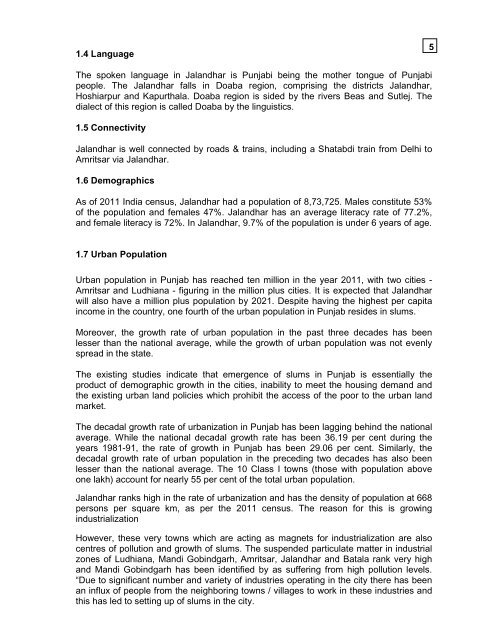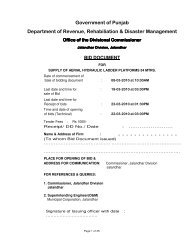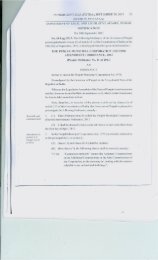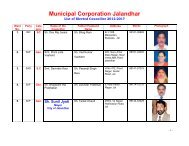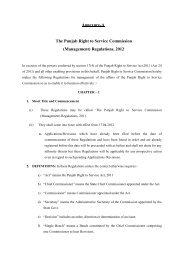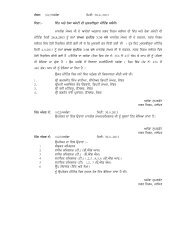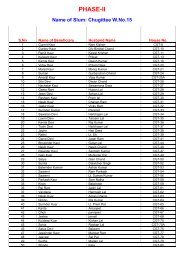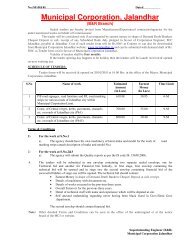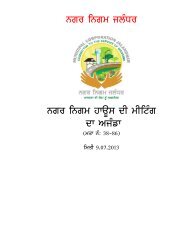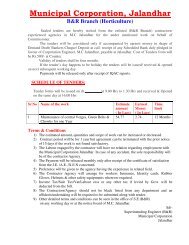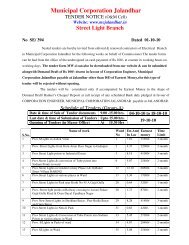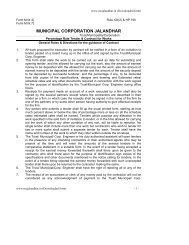Approved DPR for Rajeev Awas Yojna Project - Municipal ...
Approved DPR for Rajeev Awas Yojna Project - Municipal ...
Approved DPR for Rajeev Awas Yojna Project - Municipal ...
Create successful ePaper yourself
Turn your PDF publications into a flip-book with our unique Google optimized e-Paper software.
1.4 Language<br />
5<br />
The spoken language in Jalandhar is Punjabi being the mother tongue of Punjabi<br />
people. The Jalandhar falls in Doaba region, comprising the districts Jalandhar,<br />
Hoshiarpur and Kapurthala. Doaba region is sided by the rivers Beas and Sutlej. The<br />
dialect of this region is called Doaba by the linguistics.<br />
1.5 Connectivity<br />
Jalandhar is well connected by roads & trains, including a Shatabdi train from Delhi to<br />
Amritsar via Jalandhar.<br />
1.6 Demographics<br />
As of 2011 India census, Jalandhar had a population of 8,73,725. Males constitute 53%<br />
of the population and females 47%. Jalandhar has an average literacy rate of 77.2%,<br />
and female literacy is 72%. In Jalandhar, 9.7% of the population is under 6 years of age.<br />
1.7 Urban Population<br />
Urban population in Punjab has reached ten million in the year 2011, with two cities -<br />
Amritsar and Ludhiana - figuring in the million plus cities. It is expected that Jalandhar<br />
will also have a million plus population by 2021. Despite having the highest per capita<br />
income in the country, one fourth of the urban population in Punjab resides in slums.<br />
Moreover, the growth rate of urban population in the past three decades has been<br />
lesser than the national average, while the growth of urban population was not evenly<br />
spread in the state.<br />
The existing studies indicate that emergence of slums in Punjab is essentially the<br />
product of demographic growth in the cities, inability to meet the housing demand and<br />
the existing urban land policies which prohibit the access of the poor to the urban land<br />
market.<br />
The decadal growth rate of urbanization in Punjab has been lagging behind the national<br />
average. While the national decadal growth rate has been 36.19 per cent during the<br />
years 1981-91, the rate of growth in Punjab has been 29.06 per cent. Similarly, the<br />
decadal growth rate of urban population in the preceding two decades has also been<br />
lesser than the national average. The 10 Class I towns (those with population above<br />
one lakh) account <strong>for</strong> nearly 55 per cent of the total urban population.<br />
Jalandhar ranks high in the rate of urbanization and has the density of population at 668<br />
persons per square km, as per the 2011 census. The reason <strong>for</strong> this is growing<br />
industrialization<br />
However, these very towns which are acting as magnets <strong>for</strong> industrialization are also<br />
centres of pollution and growth of slums. The suspended particulate matter in industrial<br />
zones of Ludhiana, Mandi Gobindgarh, Amritsar, Jalandhar and Batala rank very high<br />
and Mandi Gobindgarh has been identified by as suffering from high pollution levels.<br />
“Due to significant number and variety of industries operating in the city there has been<br />
an influx of people from the neighboring towns / villages to work in these industries and<br />
this has led to setting up of slums in the city.


